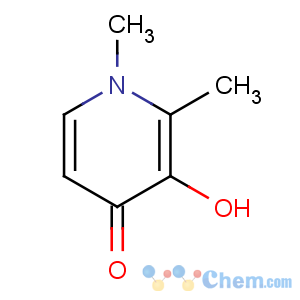Title: Deferiprone
CAS Registry Number: 30652-11-0
CAS Name: 3-Hydroxy-1,2-dimethyl-4(1
H)-pyridinone
Synonyms: 1,2-dimethyl-3-hydroxypyrid-4-one; DMHP; L1
Manufacturers' Codes: CP-20
Trademarks: Kelfer (Cipla)
Molecular Formula: C7H9NO2
Molecular Weight: 139.15
Percent Composition: C 60.42%, H 6.52%, N 10.07%, O 23.00%
Literature References: Orally active chelator that promotes urinary iron excretion. Prepn: M. Yasue
et al., Yakugaku Zasshi 90, 1222 (1970),
C.A. 74, 23102b (1971); G. J. Kontoghiorghes
et al., Arzneim.-Forsch. 37, 1099 (1987). Iron binding studies:
idem, Inorg. Chim. Acta 135, 145 (1987). HPLC determn in serum and urine: B. Dresow
et al., J. Anal. Chem. 352, 562 (1995). Clinical pharmacokinetics: F. N. Al-Refaie
et al., Br. J. Haematol. 89, 403 (1995). Clinical studies in transfusional iron overload:
idem et al., ibid. 91, 224 (1995); N. F. Olivieri
et al., N. Engl. J. Med. 332, 918 (1995). Review of pharmacology and clinical experience: G. J. Kontoghiorghes,
Ann. N.Y. Acad. Sci. 612, 339-350 (1990); F. N. Al-Refaie, A. V. Hoffbrand,
Baill. Clin. Haematol. 7, 941-963 (1994); of toxicology: G. J. Kontoghiorghes,
Toxicol. Lett. 80, 1-18 (1995).
Properties: Needles from water, mp 266-268° (Yasue); also reported as mp 263-266° (Kontoghiorghes
et al., 1987). Very bitter taste. Soly at 37° (mg/ml): water ~20 (pH 7.4). pKa1 3.3, pKa2 9.7. uv max (phosphate buffer saline, pH 7.3): 460 nm (e 3600). Hydrophilic chelator; forms red colored complexes with iron. LD50 i.p. in rats, mice: 650 mg/kg, 0.8-1.0 g/kg; i.g. in rats: 2.0-3.0 g/kg (Kontoghiorghes, 1995).
Melting point: mp 266-268° (Yasue); mp 263-266° (Kontoghiorghes
et al., 1987)
pKa: pKa1 3.3, pKa2 9.7
Absorption maximum: uv max (phosphate buffer saline, pH 7.3): 460 nm (e 3600)
Toxicity data: LD50 i.p. in rats, mice: 650 mg/kg, 0.8-1.0 g/kg; i.g. in rats: 2.0-3.0 g/kg (Kontoghiorghes, 1995)
Therap-Cat: Chelating agent (iron and aluminum).
Keywords: Chelating Agent.

